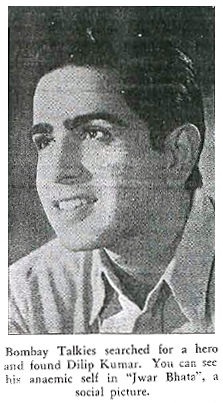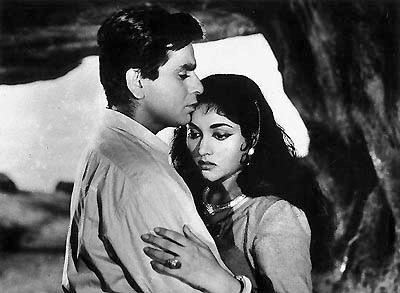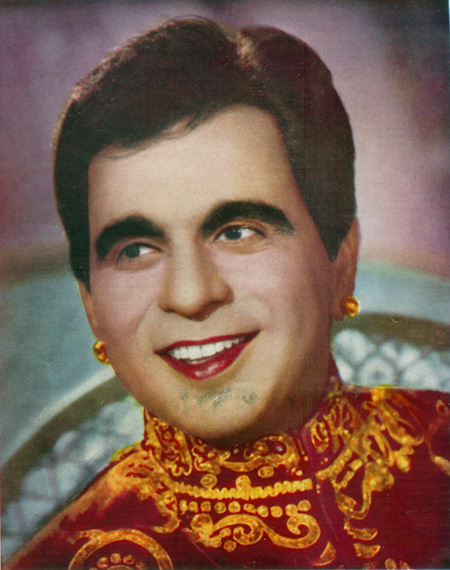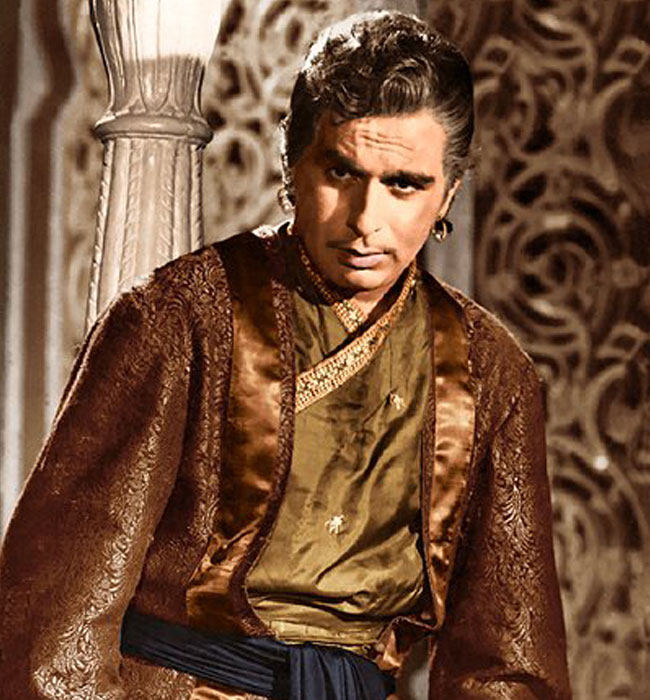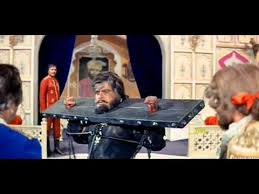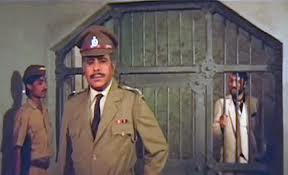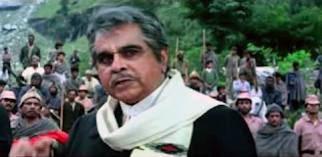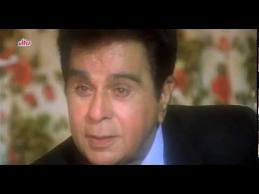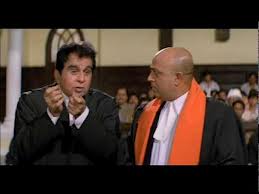Dilip Kumar: his films, their box office performance, awards, career
This article is under construction: and you can help The portions originally meant for this article have been shifted to Madhubala, actress If you wish to contribute photographs and/ or biographical details about Dilip Kumar (or any other subject), please email them to parvezdewan(a)yahoo.com |
The real superstars of Bollywood - Dilip Kumar
Jagran Junction 30 Aug, 2011
Nasir’s Eclectic Blog Tuesday, December 1, 2009
Nasir’s Eclectic Blog Tuesday, December 1, 2009
'Masti Maalgadi'/ Jagran Junction writes:
If Big B Amitabh Bachchan is considered the superstar of Hindi films of the last quarter of the 20th century, this superstar of the Hindi films of the 1950s and 60s was Dilip Kumar.
Contents |
Profile

Dilip Kumar was born on December 11, 1922 in the city of Peshawar in present-day Pakistan. His childhood name was Mohammad Yousuf Khan (Muhammad Yusuf Khan). His father, Lala Ghulam Sarwar's (Lala Ghulam Sarwar) used to sell fruit to feed his family.
Early life
His family migrated to Bombay during the Partition of India. He passed his early life in misery. The losses in the trade of his father made Dilip begin to work in a canteen in Pune. That was where Devika Rani first sighted him, and it was from there that she made an actor of Dilip Kumar. Dilip Kumar was the new name that he assumed.
At the age of twenty-five years Dilip Kumar had become the country's number one actor.
Career
1942-47
Dilip Kumar began his film career with the film Jwâr Bhâtâ ("Tides"); however, the film was not successful. His first hit, "Fireflies" ( Jugnu ) was a success. The film was released in 1947 and placed Dilip Kumar in the category of Filmistan’s successful film-stars.
In 1942, Yusuf Khan (Dilip Kumar) was in jail overnight, he refused to have his breakfast of eggs, toast and tea that was offered to him the next morning because that day Mahatma Gandhi was on n fast. The nation was busy with the Quit India Movement of 1942, for driving out the British Raj. During the next two years life was to take unexpected turn for Yusuf Khan when Devika Rani, the lady boss of Bombay Talkies, offered him a contract to act in her films.
After initial hiccups Yusuf Khan accepted the offer and thus landed a role in Jwar Bhata (1944) under the name that the First Lady of the Indian Screen selected for him – Dilip Kumar - the name that was to cast spell on generations of film goers and fraternity for the next six decades. Thus he made his debut as an actor opposite Mridula and Shamim under the direction of Amiya Chakarborty. Dilip Kumar did two more films, Pratima (1945) and Milan (1946) after Jwar Bhata.
1947-53
In 1949, Dilip Kumar and Raj Kapoor, the other rising superstar of the era, worked together with for the first time in the film Andâz . The film was a hit. Serious roles in films such as Deedâr (1951) and Devdas (1955) earned him the title King of Tragedy.
Jugnu (1947), Ghar Ki Izzat, Mela, Shaheed, Anokha Pyaar and Nadiya Ke Paar (all 1948); Shabnam and Andaz (1949); Jogan, Babul and Arzoo (all 1950); Hulchal, Tarana and Deedar in 1951; Aan, Sangdil, and Daag (1952).
Daag which was inspired by the 1950 Marathi movie, Mee Daaru Sodli, won for Dilip Kumar his first Filmfare Award in 1953 for his stellar performance of an alcoholic who having set out to purchase medicines for his dying mother, instead succumbs to his temptation and buys liquor for himself, and who finally manages to give up his drinking habits for good. In 1953, Dilip Kumar featured in Shikast and his favourite Foot-Path “where stark reality was mingled with thought-provoking romanticism.”
1954-59
Around 1954, Bimal Roy was busy shooting with Dilip Kumar his prestigious Devdas which was based on the Bengali novel of Sharatchandra Chattopadhyay.
In 1954, Mehboob Khan released his Amar, starring Dilip Kumar, Madhubala and Nimmi. From 1955 till 1959 Dilip Kumar starred in such movies as Devdas and Udan Khatola, (1955); Insaniyat, and Azaad (1956); Naya Daur and Musafir (1957), Madhumati and Yahudi (both Bimal Roy’s – 1958). During these years, Dilip Kumar won the Filmfare Best Actor Awards for his roles in Devdas, Azaad and Naya Daur! He also got the nomination for the said Award in Madhumati. Dilip Kumar did Paigham (1959) along with Raj Kumar, Vyjayantimala and B. Saroja Devi. He was cited for the Filmfare Best Actor Award nomination.
1960-69
Dilip Kumar, in 1960 he had two releases: Kohinoor and Mughal-e-Azam. He again won the Filmfare Best Actor Award for Kohinoor.
In the all-time blockbuster Mughal-e-Azam (1960), he played the role of the Mughal prince Jahangir.
In 1961 he wrote and produced and acted in Ganga Jamuna which was a trend-setting movie in many respect. This mile-stone of a movie elicited a very powerful performance from Dilip Kumar.
Sophia Loren, the two times Oscar Winner, was influenced profoundly by his acting. Astonishingly, Dilip Kumar did not win the Filmfare Award. He was of course nominated under that category.
After a three-year hiatus, Dilip Kumar accepted the role of Leader (1964) for Sashadhar Mukherjee. He also wrote the film-story which is as relevant today as it was then. His comedy role fetched him another Filmfare Award in the Best Actor Category.
His second coming
Dilip Kumar played a double role in Ram aur Shyam. The film was a superhit after a lean period that saw Leader and Dil diya dard liya flop.
His movies in the second half of the Sixties are: Dil Diya Dard Liya (1966); Ram Aur Shyam (1967), Sungharsh, and Aadmi (both 1968).
He was nominated in the Best Actor Category in all the four films. In Ram Aur Shyam Dilip Kumar played the full-fledged double role for the first time and his impact in the movie was such that it won many acclaims, including the prestigious Filmfare Award for his diverse, sensitive and powerful performance. His adverse critics, who thought he was finished, were deservingly dealt a serious blow.
However, his next few films, notably the critically acclaimed Sunghursh and Dastân did not do well either.
The 1970s
In Nineteen Seventies we have four Dilip Kumar movies: Gopi (1970), Dastaan (1972), Sagina (1974) and Bairaag (1976). All the three movies, excluding Dastaan, had his better-half, Saira Banu, as his heroine, while B.R. Chopra’s Dastaan which was a remake of Afsaana (1951) had Sharmila Tagore. In the Seventies he also had a guest appearance Phir Kab Milogi (1974) – a Mala Sinha-Biswajeet starrer.
Sagina Mahato (1970) was his diamond-jubilee hit Bengali film which was directed by Tapan Sinha. It created box-office records in Bengal.
Anokha Milan (1972) had Dharmendra along with him.
In Bairaag, Dilip Kumar had triple roles, that of a father and his two sons. Bairaag additionally had the beautiful Leena Chandavarkar also as his heroine. This was the last movie of Dilip Kumar where he was the romantic hero. Thus from 1944 to 1976 he played the roles of a film hero for 32 long years.
The 1980s and ’90s
His third coming
When Dilip Kumar came back to the silver screen after five years in Kranti (1980) it was his second innings but a successful one too. Stories were written by contemplating him in a central role. Thus we have Shakti and Vidhata (1982), Mazdoor (1983), Duniya and Mashal (both 1984), Karma and Dharam Adhikari (Both 1986), and Kanoon Apna Apna (1989), Izzatdaar (1990)) and Saudagar (1991) and Qila (1998). In Shakti Dilip Kumar had Amitabh Bachchan, the super-star of the time, pitted against him. However Dilip Kumar came out with such a brilliant performance that it won him yet another Filmfare Award in the Best Actor category. He was also nominated for the said Award in Mashal and Saudagar. Dilip Kumar's performance in Mashal was again a trend-setter and his AY BHAI....scene has been emulated in many Bollywood movies.
In the 1970s, 1980s and 1990s he worked in relatively few films. However, such was the respect and fan following that he continued to enjoy that most of the films that he acted in in his 60s were major hits: Krânti (1981), Vidhâtâ (1982), Karmâ (1986).
Duniyâ (The world; 1984), Izzatdâr (The respectable one) (1990) and Saudâgar (Merchant) (1991) were big-budget films, if not as successful. His last film was Qilâ ("Castle"/ 1998).
Quality, not quantity
In spite of being the highest paid and most successful star of the 1950s and early ’60s, Dilip Kumar acted in just 54 films. This indicated that he wanted to give only high quality performances.
In the 1950s and ’60s, Filmistan was ruled by a trinity of matinee idols: Dilip Kumar, Raj Kapoor (the most successful director of his time, though his acting was questionable) and Dev Anand.
Awards
In 1993, Dilip Kumar was given the Filmfare Award for Lifetime Achievement. The Government of India awarded him the Dadasaheb Phalke Award which is given for cinematic excellence in India. In 1997 the Pakistan Government awarded him the Nishan-e-Imtiaz which left him traumatized though the highest civilian award was also awarded to Morarji Desai much earlier.
The NTR National Award was given to him in 1997. He was also awarded the Phalke Ratna Award in 2007 and the CNN-IBN Indian of the Year Lifetime Achievement Award in 2009, along with hosts of many other awards.
DK’s body of work
Dilip Kumar movies have gone on to become great classics of Indian Cinema. In his early films, Dilip Kumar mirrors the frustration of youth in upholding life’s values and ideals. For him, it was not the case of “Everything is fair in love and war.” For him, being noble was more important than winning love by aggression or deception or crossing the limits of civility. His romantic losses and longings endeared him greatly to his generation and the next who did not want any shades of grey in the roles he played as in Amar (1954) and Qila (1998). His swashbuckling roles in Aan and Azaad sent the message of fighting evil with will and determination, taking pains in strides. When he came on the screen the hearts missed the beat and the entire audience hall lighted up at the very sight of him.
There is something enthralling about him, his mutterings, his pauses, meaningful shifting of eyes, furrowed forehead, gesturing hands, short chuckles, smiling lips, inspiring speeches, tragic monologues, Heathcliffian determination, rustic innocence, romantic disposition, and the face that expresses tragedy of the mind and happiness of the heart.
Love Life
Dilip Kumar was the most eligible bachelor of his time. When he finally tied the knots with Saira Banu he was 44 years old and she just 22 . Despite gloomy predictions and some unexpected happenings, this marriage has remained as one of the most enduring ones in the film industry.
Jagran Junction resumes below:
Dilip Kumar and Madhubala, Dilip Kumar: Bollywood films in more than Dilip Kumar lived in the news for off-screen love affair. Dilip Kumar, Madhubala, the sweethearts of the first name you can think of. Dilip Kumar and Madhubala's love, everyone knows about. The couple in the film world for his great love and war is discussed. Madhubala - Dilip Kumar, with only one of the four films. The Mughal - e - Azam (1960), his last film, which is a love story between two people as to love. Dilip Kumar was the emotional heart of the barmaid. Together - and work together in love and Dilip sir eager to marry him on the family became angry because of this, are not you will not.
Dilip Kumar, Vyjayanthimala and Dilip-kumar: Dilip Kumar, Vyjayanthimala amazing success on - screen and paired with a new round ',' Ganga - Jamuna 'and' Madhumati 'was featured in the hit films. Tragedy King Dilip Kumar as a producer of her first Bollywood film 'Ganga Jamuna' in the opposite Vy signed. Dilip Kumar Vyjayanthimala in the magic of the first film on the life of the mind, and this was the reason that he had a lot of depth to each manufacturer to make him the hero of the film was talking about.
Actor Dilip Kumar Dilip Kumar and Saira Banu, Dilip Kumar, Saira Banu was married to beauty queen in 1966. Dilip Kumar and Saira Banu at the time of the marriage was 22 at the time, Saira Banu and Dilip Saab 44 years old. Today, it is one of the pair of Bollywood's most famous couples.
Awards and recognition
Dilip Kumar, the most award-winning Guinness Book of Records, in the name of the file is. A total of eight times during his lifetime, Filmfare Best Actor Award for Dilip Kumar has not yet broken, and this could not be a record.
For the first time in 1953, the film 'stain' was awarded the prize for Best Actor. In addition Azad (1955), Devdas (1956), a new round (1957), Kohinoor (1960), the Leader (1964), and Ram - Black (1967) and power (1982) Filmfare Award for Best Actor was.
In 1993, the Filmfare Lifetime Achievement Award was awarded.
actor-dilip-kumar-gets-standing-ovation-at-national-awards by the Government of India in 1991, and was awarded the Padma Bhushan in 1995, the highest national honor, Dada Saheb Phalke Award 'presented. In 1997, the Government of Pakistan 'sign - e - Imtiaz' (Nishan-e-Imtiaz,) was awarded, Pakistan's highest civilian honor.
Rajya Sabha
Movies - with Tragedy King Dilip Kumar has also been a member of the Rajya Sabha. Even today, the most important award and Dilip Kumar Bollywood makes its presence felt in the award show. His dedication to his work at the sight of the Bollywood superstar and perfectionist people believe.
See also
=====
Jews in India At 1,800, Thane has most number of Jews in India Nergish Sunavala, TNN | Oct 20, 2013 The Times of India In 1998, the Thane Municipal Corporation was constructing a road opposite the Cadbury factory, when workers stumbled across a 500-year-old Jewish cemetery. In an attempt to preserve a tiny slice of their history before it got buried under piles of rubble, community members salvaged a few tombstones and moved them to another graveyard on Pokhran Road. "Now the old cemetery is covered by a service road," says Ezra Moses, secretary and trustee of Thane's Shaar Hashamaim (Gate of Heaven) synagogue. "But the graves are still there - 20 to 25 feet below road level."
The cemetery may no longer be visible but its existence does prove that there were Jews in Thane even in the 16th century. Today, there are about 5,000 Jews in India and Thane is home to 1,800 Jews, who worship at the synagogue, shop at the neighbourhood kosher store and come together for festivals like Yom Kippur. According to Moses, Bene Israeli Jews from the Konkan moved to Thane to take up senior posts in the British army - Thane fort was conquered by the British in 1744. The influx of Jews to Thane in the last 10 years - there are now only 2,000 Jews in the rest of Greater Mumbai - is largely due to low property prices and easy access to Jewish facilities.
Seventy-eight-year-old Raymond Samuel Evelikar, who now lives in Thane but grew up in Dongri, has seen the migration of Jews from places like Mazgaon and Saat Rasta firsthand. "When we were staying in Dongri in the '50s... we would go to a synagogue and not get place to sit," recalls Evelikar. "Now we have the same problem in Thane," says his daughter-in-law, Esther Evelikar. During big festivals, the rows of congregants extend up to the front gate. Thane's current synagogue was built in 1879 thanks in part to a generous donation of Rs1,000 by community member Samson David Mhedekar. Before it was constructed, the community worshipped at a makeshift structure built behind a bungalow in Israeli Mohalla (present-day Dhobi Ali). Shaar Hashamaim has an orthodox rabbi whose ties to the synagogue run deep. "He was born in the hospital opposite the synagogue and his circumcision, bar mitzvah and marriage were done here," says Moses.
Ever since Moses became the synagogue's secretary 34 years ago, he has championed the setting up of youth clubs (Esther Evelikar and her husband met through such a club), a men's association and an Eve's Association, which publishes a bi-annual Marathi magazine. http://photogallery.indiatimes.com/celebs/celeb-themes/shocking-celeb-deaths/articleshow/23864943.cms http://photogallery.indiatimes.com/celebs/celeb-themes/rags-to-riches-celebs/articleshow/22761383.cms
Celebs on parole or probation
The Times of India 2013
Sanjay Dutt After a stay of many weeks in jail, Sanjay Dutt has finally got some relief in the form of a parole, a provisional release of a prisoner who agrees to certain conditions prior to the completion of the maximum sentence period. However, there are many celebs who have been or are on probation which in legal language is a period of supervision over an offender, ordered by a court instead of serving time in prison. We take a look at the list of celebs who have been granted parole or probation.
=====
===============
IndianHerald February 14, 2012.
In a genuine effort to maintain the Gujarati tradition and culture in Australia, since the last fourteen years, Vipul Vyas & his team of local artists, through Mahavira Production, have presented family dramas for Indian audience. Recently, as a part of the “50 Year Celebration for the formation of State of Gujarat”, Mahavira Production produced two successful dramas. To mark the beginning of 50th Year celebration “Chal Ramiye Hu Tu – Tu Tu” & to end the 50th year celebration “Ba Bagade To Baar Vagade” were staged and well received in Sydney, Melbourne, Brisbane and Perth.
========
This is a collection of articles archived for the excellence of their content.
Readers will be able to edit existing articles and post new articles directly
|
============
The Times of India Sept 2013
Aditya Pancholi married Zarina Wahab in 1986 against all odds. Zarina is 6 years older than Aditya and has stood by him in good and bad times.
Aishwarya Rai to make a connection with the Bachchan family. Her mixed-age marriage with Abhishek Bachchan has filled her chasms in life.
Arjun Rampal is married to former supermodel Mehr Jessia who is two years older than him. The couple married in 1998 and are proud parents of two beautiful daughters
Farah Khan and Shirish Kunder met on the sets of Main Hoon Naa and love blossomed soon. Farah is eight years older than Shirish, but that didn't stop these love birds from tying the nuptial knot.
Farhan Akhtar met Adhuna, who was six years older to him, during the making of Dil Chahta Hai, and was immediately bowled over. They got married in the year 2000 and are blessed with two daughters.
Parmeet Sethi fell in love with an already-divorced Archana Puran Singh at first sight. Despite Archana being 7 years older to him, Parmeet had no hesitation in taking their relationship forward.
Rajnikanth’s daughter Aishwarya entered into the wed-lock with actor Dhanush who is 2years younger to her. It seems it was just the camaraderie and spending rest of the life together for the couple in love.
Sachin Tendulkar and he married Anjali who was six years elder to him.
Saif Ali Khan and Amrita Singh got married in 1991 when Saif was just a rookie and Amrita a well-established actress. Amrita was seven years older than Saif. The marriage lasted 13 years during which the couple was blessed with two children.
Shilpa Shetty married Raj Kundra who is three years younger than her. They met in London and fell in love in no time. The couple tied the knot in 2009 and are now a proud parent of Viaan.
Sunil Dutt and Nargis started when the former saved latter's life during the making on Mother India. Nargis was a year older than Sunil Dutt and a more established actor than he.
====================
Tamil Nadu takes India's solar power capacity up 30%
Sushma U N, TNN | Sep 17, 2013
Tamil Nadu takes India's solar power capacity up 30%
India has 1,759.43MW of grid-connected solar power, with close to 800MW coming from Gujarat. The projects are expected to be ready for commissioning next year.
CHENNAI: India's installed solar power capacity is poised to jump 30% with the Tamil Nadu government close to signing power purchase agreements for 700 megawatts (MW) by the end of October.
Once the plants are up and running, Tamil Nadu will have the second largest solar power capacity in India after Gujarat, the pioneer in such projects in the country.
India has 1,759.43MW of grid-connecte
d solar power, with close to 800MW coming from Gujarat. The projects are expected to be ready for commissioning next year.
As part of TN's solar power policy, which aims at installing 3,000MW of capacity by 2015, a total of 52 companies will sign agreements with the Tamil Nadu Generation and Distribution Corporation (Tangedco) for capacity totalling 698MW at a tariff of 6.48 per unit (with a 5% increase annually for 10 years).
This comes at a time when the country's national solar policy is tottering. The second phase of the Jawaharlal Nehru National Solar Mission (JNNSM) has been delayed by over five months with no sign of the programme being kick-started any time soon.
Solar power is the most expensive form of renewable energy and rupee depreciation has added to the woes of companies importing high-end photo voltaic panels.
"There has been a lot of uncertainty over solar power companies and negativity had set in. But now there are projects in the pipeline and activity for players across the board will go up," said Madhavan Nampoothiri, founder and director of RESolve Energy Consultants, an energy consultancy firm.
Last week, Tangedco held individual meetings with solar power developers asking them to submit documents for proof of land ownership and bank guarantees for financing. "Thirty companies are yet to submit the documents and we have given time till October 30. Once this is in place, power purchase agreements will be signed," a senior official from Tangedco said.
Companies that have the documents in place have started working on the project. "The meeting with the Tangedco chairman and other members was a manner of assurance of support and we have started progress on our project. The team is on the site and we are in talks with banks for financing," said T R Kishor Nair, President, Welspun Energy, which is setting up a 60 MW plant in Trichy district. Solar policies in other states haven't made as much progress and capacities also aren't as large as in Tamil Nadu. While Andhra Pradesh has a target of 1,000 MW, tariff is a deterrent for investors as it is fixed at Rs 6.49 with no annual hike. The programmes in states like Punjab (300 MW) and Karnataka (130 MW) are on a smaller scale and are in the nascent stage. What adds to Tamil Nadu's attractiveness is that the state has high solar radiation of 5.6 - 6.0 kWh per square meter with around 300 clear sunny days in a year, the third highest in India.
============
Three Indian-Americans among America's 400 richest
IANS | Sep 17, 2013
WASHINGTON: Three Indian-Americans figure among America's 400 richest people
Topping the Indian-American list was Florida outsourcer Bharat Desai and family with a net worth of $2.2 billion in the 252nd position. He was followed California software manufacturer Romesh T Wadhwani with a net worth of 2.1 billion. California venture capitalist Vinod Khosla was ranked 352 with a net worth of $1.5 billion
====
Calcutta University worst Indian performer in global rankings
Kounteya Sinha & Prithvijit Mitra, TNN | Sep 17, 2013
LONDON/KOLKATA: India's academic institutions have slipped down the rungs in global rankings but the university that once led the order of excellence at home has taken the worst tumble.
Calcutta University, the 157-year-old institution that counts Meghnad Saha, Bankim Chandra Chatterjee, Rajendra Prasad, Subhash Chandra Bose and Nirad C Chaudhuri among its alma mater, has dropped 100 places in world rankings to below 700. Not a single Indian university figured among the top 200 in the QS World University Rankings.
The ranks were given on four key parameters: research , teaching, employability and internationalization. The methodology has six indicators : academic reputation (40%), employer reputation (10%), and facultystudent ratio (20%), citations per faculty (20%), international students (5%) and international faculty (5%). CU was among the worst performers in all parameters, showing its precipitous decline as a world-class institution. The ranking was a wakeup call for the Mamata Banerjee government, which has vowed to restore the state's academic institutions to their old glory. Education minister Bratya Basu, however, said the parameters for rankings were not always applicable to Indian institutions.
IIMC among top 20 B-schools
C alcutta University's dismal performance has somewhat been mitigated with the Financial Times Global Rankings for Masters in Management programs putting IIM-Calcutta among the top 20 in the world. At 19th, the IIM-C is placed above the prestigious London School of Economics.
'Didn't participate in rankings'
They award points on international faculty, students from abroad and number of Nobel laureates, which are obviously very few in Indian universities. CU is performing very well and has received accolades from all over the world. So, I don't see any reason to panic or fret," Basu said.
CU vice-chancellor Suranjan Das said the university didn't participate in the rankings. "They had asked for data but we didn't provide it to them. Some of the parameters included were not applicable for CU, like international faculty, international students, student-teacher ratio. We function under a different paradigm. On the other hand, the methodology for assessing excellence which should be applicable for India is the input-output ratio. What should be considered is the number of graduates we produce with the limited funds that are allocated to us. That our university has still got a rank despite the severe constraints is indeed commendable," said Das.
In 2012, the University of Kolkata - students of which included Nobel prize winners was ranked around 600 among the world's top colleges and universities. Pro VC (academics) of CU Dhrubajyoti Chattopadhyay termed the drop in rankings as 'unfortunate'. "While the other universities and institutes have made considerable progress, we have lagged behind. We have not been pro-active enough to stay ahead. This is a wake-up call for us and let's hope it ensures an all-out effort to turn things around," said Chattopadhyay.
The QS World University Rankings published last week featured 11 Indian institutions in the top 800 with the highest ranking going to IIT Delhi, placed 222 on the list. Two other institutions made it to the top 300 - IIT Bombay (233) and IIT Kanpur (295). IIT Madras was ranked 313 while IIT Kharagpur stands at 346, the only Indian institute that has gained ranking from 349 in 2012.
==================================
This is a collection of articles archived for the excellence of their content.
Readers will be able to edit existing articles and post new articles directly
|
Delhi gang rape of Dec 16, 2012
Delhi gang rape: Case diary
Smriti Singh, TNN | Sep 13, 2013
NEW DELHI: After a nine-month-long trial, fast track court on Friday handed down death penalty to all the four convicts in the Delhi gang rape and murder case. The court while pronouncing the judgment said that "it cannot turn a blind eye on the rising cases of sexual assualt against women" and that the incident shook the "collective conscience of the society".
CASE DIARY
Dec 16, 2012: Nirbhaya (a pseudonym given by The Times of India), a 23-year-old paramedic student, gang-raped and assaulted by six men in a private bus and thrown out of the moving vehicle along with her male friend
Dec 17: Police identify four accused-Ram Singh, his brother Mukesh, Vinay Sharma and Pawan Gupta
Dec 18: Ram Singh and three others arrested
Dec 20: Victim's friend testifies
Dec 21: Juvenile perpetrator nabbed from Anand Vihar bus terminal in Delhi
Dec 22: Sixth accused, Akshay Thakur, arrested in Aurangabad district of Bihar. Nirbhaya, fighting for life in Safdarjung Hospital, records statement before SDM
Dec 26: Government decides to take her (given the pseudonym Damini by Hindustan Times) to Singapore's Mount Elizabeth Hospital following a cardiac arrest
Dec 29: Nirbhaya dies in Singapore at 2.15am; police add murder charge in FIR
Jan 3, 2013: Police file chargesheet against five adult accused
Jan 7: Court orders incamera proceedings
Jan 17: Fast-track court starts proceedings
Feb 2: Frames charges against five adult accused
Mar 11: Ram Singh commits suicide in Tihar Jail
Mar 22: Delhi HC allows national media to report proceedings
Aug 22: Final arguments begin
Aug 31: Juvenile Justice Board sends juvenile accused to a home for 3 years
Sep 3: Fast-track court reserves order for September 10
Sep 10: Court holds the accused guilty of 13 offences including gang rape, unnatural offence, murder, dacoity, conspiracy, kidnapping and destruction of evidence.
Sep 11: The quantum of sentence to the four convicts in the Delhi gang-rape case to be announced on September 13, 2013
Sep 13: A special Delhi court on Friday awarded death sentence to all four convicts in the December 16 gang-rape case. The court said the case falls under 'rarest of rare' category.
THE TRIAL
Trial concluded in 130 effective hearings over 7 months; 85 prosecution witnesses examined; 17 defence witnesses. Final arguments concluded on Sep 3 and the accused were held guilty of all charges on Sep 10.
KEY WITNESSES
Nirbhaya's male friend identifies all accused and describes their role and sequence of events to the court in in-camera proceedings.
Investigating officer identifies all accused and the evidence. Also tells the court about details of their arrest.
Metropolitan magistrate records the statement of Nirbhaya, considered as dying declaration of the victim.
DNA expert says bloodstained clothes recovered from accused match with Nirbhaya's.
Doctors at Safdurjung Hospital say injuries inflicted upon the 23-year-old were enough to cause her death.
Statements of doctors at the Singapore hospital recorded through video-conferencing . They also analyze slides containing samples of cells and tissue of Nirbhaya.
IMPORTANT EVIDENCE
Dying declaration of Nirbhaya. Bus in which the incident took place. CCTV footage of the bus. Statement of Nirbhaya's male friend. Forensic and medical evidence, including bloodstained clothes of the accused DNA samples. Court convicted the four by relying on the victim's dying declaration and forensic evidence.
WHAT THE CONVICTS CLAIMED
Mukesh Singh
Claimed innocence; said his brother Ram Singh had asked him to drive the bus as the others were drunk. 'I did not leave the driver's seat even for a moment. The door of the cabin was shut, so I couldn't hear the voice clearly'.
Vinay Sharma and Pawan Gupta
They went to attend a musical event in south Delhi and were not in the bus. They had a fight with Ram Singh, so he and Mukesh falsely implicated them.
Akshay Thakur
He was not present in the bus. 'I was not in Delhi as I had left for my village on December 15, 2012'. ==============================================
2012-13: Economic investments in states
Odisha top investment destination in India
Through a dozen projects funded by bank loans, Odisha managed to get investors to commit to around Rs 53,000 crore investment, a 27% share of all-India investments.
Sidhartha, TNN | Sep 12, 2013, 01.20AM IST
NEW DELHI: Odisha emerged as the hottest investment destination for new projects as investor interest in "prosperous" states such as Maharashtra, Gujarat, Karnataka and Tamil Nadu declined during 2012-13, latest data released by the Reserve Bank of India showed.
Through a dozen projects funded by bank loans, Odisha managed to get investors to commit to around Rs 53,000 crore investment, a 27% share of all-India investments. In contrast, Maharashtra is expected to get investment of around Rs 21,400 crore in 70 projects, or 10.9% of the pie. Punjab was the other surprise, moving to the third spot with a dozen projects expected to generate investments of over Rs 20,600 crore.
The numbers aren't good news for the BJP and Gujarat chief minister Narendra Modi, who are using high economic growth and investment in the western state as a key theme ahead of the 2014 general elections. Similarly, Karnataka, where the principal opposition was in power until recently, has lost sheen amid corruption-related charges. But Andhra Pradesh (Rs 11,000 crore) retained the fourth slot despite the state being hit by Telangana-related protests for the past several months, while Gujarat (Rs 10,600 crore) ranked fifth.
"Share of Odisha has increased over the years due to its mineral resources. While Gujarat attracted investment proposals mainly in industries like infrastructure, petroleum products, metal and metal products and textiles, project investments in Maharashtra have been across almost all industries with larger share coming from infrastructure (mainly power and telecom), transport services, textile and construction," RBI said in its analysis.
A senior government in the Odisha government told TOI that the bulk of the investments are proposed in coal mining, steel and a few port projects. Analysts warned that not all planned investments fructify.
At the all-India level, however, the numbers confirmed the go-slow on investments with the number of new investment intentions by 969 companies adding up to Rs 2.6 lakh crore in 2012-13, compared to Rs 2.5 crore by 1,127 companies in the previous year. This means that in terms of the amount involved the increase is barely 5%. Companies have cited lower demand and higher interest rates for slowing down capital expenditure for expansion as well as new projects.
The numbers also showed a slowdown in the infrastructure sector, both in terms of number of projects sanctioned as well as the amount. The good news was renewed interest in telecom in 2012-13, while sectors such as metals, cement and construction too seem to have fared better.
The central bank predicted subdued investor sentiment during the current financial year as well, as demand remains weak and inflation is expected to inhibit significant reduction in interest rates. "While the government has initiated some steps in the recent past to improve investment climate, results are yet to be visible," it added.
RBI's annual compilation is based on data collated from banks and financial institutions that finance the projects, foreign borrowings as well as fund-raising from the stock market. The data on states is, however, based on funding provided by banks and FIs.
====
law
Flat (apartment), purchase of: India
‘Can’t charge flat buyer extra for parking slot’
Rebecca Samervel, TNN | Sep 11, 2013
MUMBAI: Emphasising that a flat buyer cannot be charged extra for a car parking space, a consumer forum has fined a developer that committed this "unfair trade practice".
The Central Mumbai District Consumer Disputes Redressal Forum last week directed Tata Housing Development Company to refund Rs 50,000 to Ghatkopar-based Suresh Mehta and pay him compensation of around Rs 20,000.
"Car parking area is the common area of the society. Therefore, the opponent (the developer) had no right to charge any amount for the sale or use of the parking space," observed the forum. It took into consideration a Supreme Court judgment which held that a developer can only sell a flat and has no right to sell a parking space.
In his complaint, filed with the consumer forum last year, Mehta had said that he purchased on June 30, 2010, an apartment and car parking space at Betegaon, Palghar, for Rs 17.4 lakh. He maintained that Rs 50,000 was taken from him for car parking and another Rs 50,000 as clubhouse development charges.
Mehta said he came across a judgment in August 2010 that held that a builder or developer cannot sell stilt or open parking as the space is part of society common area. The verdict also held that, once the occupation certificate is issued and the society formed, the developer ceases to have any title on the open space.
Through a letter dated December 23, 2010, Mehta demanded a refund from the developer. He was told in response that the car parking was not sold; the developer said he was issued a right to use the space. Aggrieved, Mehta filed a complaint with the forum. The developer repeated its stand in the forum.
The forum said the agreement showed that the total amount paid by Mehta included charges for the parking space. "The documents on record corroborate the contention of the complainant that the flat's price was Rs 16.44 lakh and that he was required to pay Rs 50,000 for car parking space." The forum held that this amounted to an unfair trade practice.
================================
law
Adultery: India
Adultery is not cruelty, Supreme Court says bb
Dhananjay Mahapatra, TNN | Sep 10, 2013
NEW DELHI: Merely being "intimate" with another woman is not sufficient ground for a man to be held guilty of inflicting cruelty on his wife on the charge of failing to discharge his marital obligations, the Supreme Court ruled on Monday.
Only if treatment meted out to the wife is of a nature as is likely to drive her to commit suicide will it fall within the ambit of Section 498A of IPC, a provision of the penal code providing up to three years in jail, said the bench.
"We are of the view that the mere fact that the husband has developed some intimacy with another, during the subsistence of marriage, and failed to discharge his marital obligations, as such would not amount to cruelty," said a bench of Justices K S Radhakrishnan and P C Ghose.
The SC reading of what constitutes cruelty brought relief to a man who had been convicted by both the trial court and the high court for behaviour that resulted in the suicide of his wife due to an alleged extra-marital affair at his place of work.
The ruling came in a case where the wife committed suicide suspecting the husband of intimacy with a woman colleague in office. The trial court and the Gujarat high court held him guilty under Section 498A for causing cruelty to his wife and under Section 306 of IPC for abetting suicide.
"Harassment, of course, need not be in the form of physical assault and even mental harassment also would come within the purview of Section 498A IPC. Mental cruelty, of course, varies from person to person, depending upon the intensity and the degree of endurance, some may meet with courage and some others suffer in silence, to some it may be unbearable and a weak person may think of ending one's life," the bench said.
But keeping in view the case before it, the apex court set aside the concurrent judgments to exonerate the man of any wrongdoing and said, "We, on facts, found that the alleged extra-marital relationship was not of such a nature as to drive the wife to commit suicide or that A-1 (husband) had ever intended or acted in such a manner which under normal circumstances, would drive the wife to commit suicide."
Writing the judgment for the bench, Justice Radhakrishnan said to charge a husband for abetment of suicide, the prosecution must establish that the wife's suicide was a direct result of the extra-marital affair.
"Prosecution has to establish beyond reasonable doubt that the deceased committed suicide and the accused abetted the commission of suicide. But for the alleged extra-marital relationship, which if proved, could be illegal and immoral, nothing has been brought out by the prosecution to show that the accused had provoked, incited or induced the wife to commit suicide," the court said.
"We have on facts found that, at best, the relationship of A-1 (the husband) and A-2 (the other woman) was a one-sided love affair. The accused might have developed some liking towards A-2, his colleague, (but) all the same, the facts disclose that A-1 had discharged his marital obligations towards the deceased. There is no evidence of physical or mental torture demanding dowry," the court said.
Referring to the wife's suicide note, the bench said, "On reading the suicide note, one can infer that the deceased was so possessive of her husband, and was always under emotional stress that she might lose her husband. Too much of possessiveness could also lead to serious emotional stress, over and above the fact that she had one abortion and her daughter died after few days of birth."
========================
Development
Water supply: India
22 of India's 32 big cities face water crisis
Dipak Kumar Dash, TNN | Sep 9, 2013
Experts say that population of cities such as Jamshedpur, Dhanbad and Kanpur have increased manifold, resulting in increased demand for water. (TOI photo by Balish Ahuja)
NEW DELHI: Water scarcity is fast becoming urban India's number one woe, with government's own data revealing that residents in 22 out of 32 major cities have to deal with daily shortages.
The worst-hit city is Jamshedpur, where the gap between demand and supply is a yawning 70%. The crisis is acute in Kanpur, Asansol, Dhanbad, Meerut, Faridabad, Visakhapatnam, Madurai and Hyderabad — where supply fails to meet almost 30% of the demand — according to data provided by states which was placed in the Lok Sabha during the recently-concluded Parliament session by the urban development ministry.
The figures reveal that in Greater Mumbai and Delhi — which have the highest water demand among all cities — the gap between demand and supply is comparatively less. The shortfall is 24% for Delhi and 17% for Mumbai. However, the situation is worse than that.
For example, in Delhi, 3,156 million litres of water (MLD) is supplied against the requirement of 4,158. But around 40% of the supply is lost in distribution resulting in a much wider gap between demand and supply than what's recorded.
"In official records, many cities might be getting adequate water. But because of faulty engineering and poor maintenance, the actual availability is much less," said Dilip Fouzdar, a water resource management professional.
He added that though Mumbai gets good rains in comparison to many other big cities, very little of this is actually harvested. "A robust system to recharge ground water can make the city avoid any water shortage," Fouzdar said.
Experts say that population of cities such as Jamshedpur, Dhanbad and Kanpur have increased manifold, resulting in increased demand for water. But the deeper problem is one of short-sightedness, they said — governments wake up to water demand in a city after the situation has become acute. One such example is Gurgaon, where a major water channel was built almost 15-20 years after large-scale development happened.
The government records show 10 major cities in the country either meet daily water requirements or have surplus supply. Nagpur tops this list, reporting 52% extra supply while Punjab's industrial city, Ludhiana, has 26% surplus supply. Other cities managing to meet their water demand include Vadodara, Rajkot, Kolkata, Allahabad and Nasik.
What's also a cause for concern is that majority of the cities are depending on water sources from outside.
In Kochi, the daily water demand is 274 MLD while the supply is 250 MLD per day. Officially, daily water supply in the city is enough to meet almost 90% of the demand provided there is no loss or leakage in distribution.
=======================
Fauna
Dolphins
Dolphins in the Beas/ Harike
For the first time, a dozen dolphins spotted in Beas
Yudhvir Rana, TNN | Sep 9, 2013
The monthly monitoring of the dolphins is conducted jointly by teams of World [Wildlife] Fund for Nature and Harike wildlife sanctuary
AMRITSAR: For the first time, the officials of Harike wildlife sanctuary, 60km from Amritsar, have spotted 12 Indus dolphins, an endangered species, in a single sighting.
Divisional forest officer M Sudhagar told TOI on Sunday that during the monthly monitoring, they spotted a dozen Indus freshwater dolphins in three groups. "With this single sighting, we can estimate that their number could be around two dozen in and around the sanctuary," the officer said.
The monthly monitoring of the dolphins is conducted jointly by teams of World Wide Fund for Nature and Harike wildlife sanctuary.
The endangered freshwater Indus dolphin (Platanista minor) is found only in this stretch of India. Around six years ago, the Harike wildlife sanctuary officials had spotted a pair of freshwater dolphins for the first time in the country at the confluence of Beas and Satluj rivers.
As the word spread, the government had announced to launch a conservation project for dolphins and develop the area as a major tourist spot, but nothing happened till now.
Indus dolphin is one of the world's rarest mammals and most endangered cetaceans.
Village as tourist destination
Indus dolphin is one of the world's rarest mammals and most endangered cetaceans. Only about 1,100 such unique species exist today in the lower reaches of the Indus in Pakistan. Their number had drastically declined since the construction of dams on the river.
The dolphins were found in the 75km stretch of the Beas, which also includes around 3km stretch of the Harike wildlfe sanctuary. Divisional forest officer M Sudhagar told TOI on Sunda that besides monthly monitoring of dolphins, no project for their conservation or protection had been launched so far.
The officer added that the department had chalked out a plan to develop Karmowal village as a tourist destination by taking some rented accommodation but that project also didn't take wings.
Sources said the state government had not sent any proposal to the Centre in this regard and the government had not shown any interest in declaring the sight as conservation reserve to protect the dolphins. The officer added that the department had chalked out a plan to develop Karmowal village as a tourist destination by taking some rented accommodation but that project also didn't take wings.
